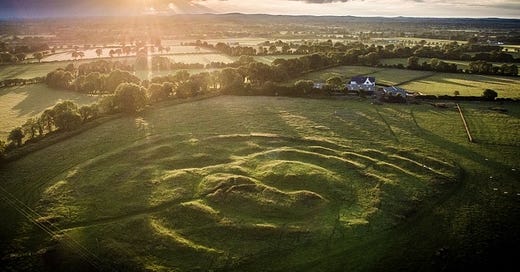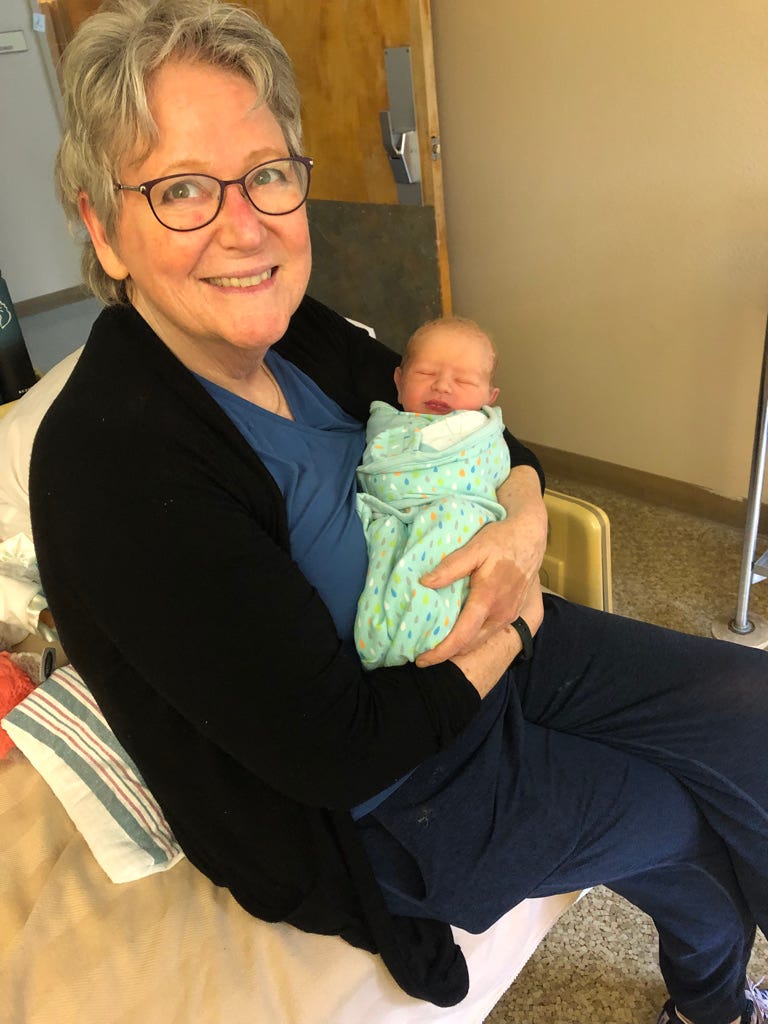Birth and Death in the Time of Samhain
Welcoming my new grandson, two weeks so far breathing air
Dear Friends,
Blessings to you at this sacred time of year, on the Irish festival of Samhain.
Before I share my essay below, “Birth and Death in the Time of Samhain,” I want to take a moment and acknowledge that my world, our world, changed on October 7, 2023. I have been anguished with grief, for though I am not Jewish or Palestinian, in some ways I feel I am both. I have beloved teachers, friends and kin who are Jewish, with whom I share deep love. I have family, nieces and nephews and their beloved children who are Palestinian American, who are as close to me as my own breath and cherished as my own soul.
This affiliation with both peoples is also in my Irish blood, for my ancestors knew what it was to be forgotten by the world, left to die in violence or illness, forced to migrate, and reviled for simply being who they were.
In these weeks, like people all over the world, I feel the anguish of many, many beloved people in my life for all they are going through, both current pain and ancestral trauma. I am sending my love to all of you, my protection, my hope, my light, all my prayers.
And still, my world changed again on October 17, 2023. And it is this change, the one right in front of me, the miracle I will never experience again, that I have endeavored to keep my heart open to, the one I write about here.
May all humans be safe and well. May our beloved Earth and all its lives blossom.
Carolyn
Birth and Death in the Time of Samhain
There are two ways to live: you can live as if nothing is a miracle; you can live as if everything is a miracle. —Albert Einstein
YESTERDAY WAS SAMHAIM, November 1, and indeed the boundary between the worlds has opened.
Of course, few could escape Halloween these past few days, a holiday that was carried by emigrants from Ireland, Scotland and Wales all over the world as a remnant of the Celtic festival known as Samhain (pronounced sah-win).
In old Ireland, Samhain was a major fire festival to mark the beginning of “the dark half of the year,” a time to gather the tribe to prepare for the coming winter. Herds of cattle and sheep were brought down from the hills, the last of the potatoes and other root crops were dug up from the earth, food was stored and supplies prepared. Cattle that would not make it through the winter were slaughtered and prepared for ritual feasting.
The people gathered on the sacred hill of Tlachtga (now known as the Hill of Ward) and druids made a bonfire so large as to be seen from other ceremonial hills. Once the Tlachtga fire was sighted, other bonfires were lit, spreading throughout the island. Most household fires would be extinguished and relit from one of the ceremonial bonfires—for protection, cleansing and blessing for the family in the coming months.
This ritual was then followed once again six months later for Bealtaine, to honor the beginning of “bright half of the year.”
As a border between the two parts of the year, Samhain was and is a liminal time. It is a moment when the Otherworld opens up and the spirits are around and mingling with human beings. Fairies or the sidhe, ancient gods and goddesses, and the spirits of the ancestors and the dead are close by. It is a time to honor one’s own venerable ancestors, and to protect oneself from troubled spirits or trickster fairies, who were said to be able to shapeshift into other things or animals, and might even appear to be people you know.
In old Ireland during Samhain, the bones of slaughtered animals would be tossed into the large ritual fire making a bone-fire (thus originating the word “bonfire.”) As a major festival often mentioned in early Irish mythology as a time when significant events and battles happened, this portal moment when otherworldly spirits were nearby was the occasion for feasting, dancing, music and trickery. Fortune-telling and divination were done, and offerings made to the ancestors. Many people wore costumes, often with masks of animals, ghouls or beasts, in hopes of fooling any worrisome spirits.
In later times the Christian Church—unable to stop the old Celtic festival days from continuing—followed its long practice and claimed the liminal moment of Samhain as its own, renaming it “All Soul’s Day” (November 2), when the “faithful departed” are honored. And as usual, the Irish continued on in their own way.
Traditions in Ireland, Scotland and Wales included leaving offerings outside the house for traveling spirits and fairies. Many familes carved a lantern from a large turnip with supernatural faces, and put it in the windowsill to represent otherworldly spirits or to protect the household from them. People began going door to door with masked or blackened faces asking for food for Samhain feasts or offerings for the sidhe. Samhain also became a time of trickery and fun with all the ghoulish costimes.
One old Irish practice was to honor the family ancestors by stoking up the fire before bed on Samhain eve, and gathering all the household chairs around the hearth. The family would leave out a bit of food, and as they slept their ancestors would feel welcome, and make themselves at home as a blessing for the year.
Samhain is a powerful moment; everyone in the northern hemisphere feels that we are making an important transition. In the Mexican tradition, this liminal time is called Dia de los Muertos, or Day of the Dead. The ancestors are honored and celebrated with profound rituals of remembrance, fantastic feasts, music, dancing and costumes.
We haved reached the end of the part of the year when the light is pronounced, and are beginning of an entirely new time when the intelligence of the dark will be available. It is possible to access the depth of inner life embodied in the womb of the mother and the fecundity of the self. We do, as well, sometimes face our human fears and the difficult journeys of initiation and surrender which are embodied by the dark—these initiations, too, are often occasions for profound growth.
AS IT HAPPENS, I HAVE SPENT the last two weeks with an otherworldly figure. Only fifteen days ago, fantastically, he could breathe water. He understood darkness as pure comfort and fecundity, the wide-open world of the dreamtime, the warmth of amniotic fluids in my daughter’s womb, the rustle of her heart when she slept, and the song of her voice when she was up and about, carrying him everywhere she went.
It was not possible for him to be cold or hungry in his watery world; every need was met. Incredibly, in what can only be called alchemy or magic, in just a few months the cells of his body had merged and divided and grown into things that simply didn’t exist before. Our world does this all the time, so we are used to it. The flower emerges from the seed, the kitten from her mother, the great tree from the acorn. Things appear or are made out of nothing, or more accurately, are engineered to grow from a few things into another thing entirely.
We become used to it. But just now, I am not used to it.
Not with this otherworldly figure so close by. He is still partly an aquatic being. His skin, the softest, most tender touch imaginable, still emanates a glow of liminal ease. He is still flaking off his watery skin surface, and he just lost the last of the cord which connected him to his mother. His face is both craggy and smooth, at one moment dimpled and boylike, at another a wrinkled old man, and then utterly froglike and amphibian, still partially swimming.
He is a newborn, a shapeshifter, gangly and fresh, like the young crow from the egg, or the just-emerged fawn from her mother’s belly. How could he not be? Fifteen days ago he had never processed light or imbibed air. He was designed to do these things, effortlessly—and he has. But until fifteen days ago, he never had.
In that dark dreamtime womb, what he did was grow his tender, brilliantly engineered eyes. Those eyes didn't used to be here, and now they are. I look at him and find this incredible. Or his fingers, complete with perfect, miniature fingernails. Not to mention all the complex, amazing rest of him. All this was done while he slept and dreamed, through the innate intelligence of his human genes. This is the life, the alchemy, the natural magic, of which we are indelibly a part. No one has to look very hard at all to be simply overcome with awe.
And I am overcome. Tears come to my eyes as I write this. Last night, on the eve of Samhain, he and I sat quietly in the living room. He was fed, otherworldly and happy, and he lay on my chest and I felt his heart and I felt his breath and he felt mine and effortlessly for some span of time we were simply one.
That is what this miracle boy has taught me. We are simply one. Not he and I, though I mean that also in that moment. I mean that we are all simply one. We are all the common heartbeat of the Earth. We all grew out of nothing. Or we all took other materials and transformed them into ourselves. We do this every day, imbibing food and liquid and then alchemizing them into ourselves. So too does the crow and the fawn and the frog. Everywhere I look, everything I see is alchemy, is miracle.
It is Samhain, and the border between the worlds is open. Or perhaps the teaching, the lesson, is that there really is no border. The Otherworld and this world are one. That old man I see in my grandson is perhaps the echo of an ancestor. So too the amphibious frog, some ancient forebear from before we humans evolved out of the ocean. All these separate worlds are all one world, or many variations on one world—a gloriously diverse One. A world in which, as the physicist said, it is all a miracle.
Welcome to my grandson, Cooper James Lancaster. You are miracle and we are miracle and you are held in our arms. Thank you, already, for being my teacher.
NOTES
Today the Irish celebrate Samhain/Halloween in a fantastic way at the three-day Pucá Festival. Working in partnership with Irish artists, seanchaí storytellers, and the local community, Púca offers ancient ritual, storytelling and traditional music mixed with fabulous light shows, commedians, contemporary Irish music concerts, food and costumes. Held at the 12th century Trim Castle on the River Boyne in County Meath.
On Israel/Palestine, I highly recommend Deena Metzger’s latest essay on Substack, “What Dinah Thought - A Story for Israel/Palestine.” A beautiful and healing work. And I am always moved and educated on the kinship between Palestinians and Jews by Jewish Voice for Peace.






Dear Carolyn - Blessings on you & your dear grandson. Such an amazing gift for all of us, each new life adds a glimmer of hope & connection. And your writing shows us the way. . .
Beautiful photo of you Carolyn and your lovely grandson Cooper.
May he bring joy to you all and Bless him and keep him safe ❤️❤️☘️🇮🇪☘️🇺🇲🇺🇲